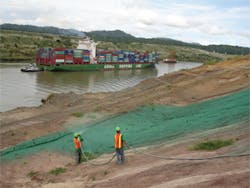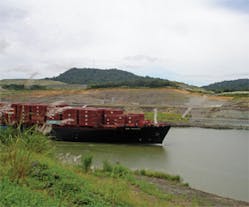Every erosion control project is mission critical, but the Panama Canal expansion project, completed in June 2016, is arguably in a class by itself, given the scale of the undertaking and the waterway’s strategic importance to international commerce. The dirt-and-rock slopes created from the dredging of nearly 50 million cubic meters (65,400,000 million cubic yards) of underwater material during the construction had to be stabilized to prevent sediment runoff into the canal and new locks. Failure would lead to environmental violations and a costly cleanup to keep the canal waters clear.
Contractors initially addressed the issue by hydraulically seeding a combination of grass seed and wood fiber mulch on the 30- to 45-degree slopes, followed by installation of costly turf reinforcement mats or erosion control blankets over the treated areas to help hold the seed in place. This was critical during Panama’s eight-month rainy season and common three- to four-hour downpours, totaling nearly 137 inches of rain annually.
Early in the project, however, that two-step process and associated costs were eliminated by switching to Profile Products’ Flexterra High Performance-Flexible Growth Medium (HP-FGM)—a patented, hydraulically applied, fully biodegradable solution that bonds instantly to the soil, promotes rapid vegetation growth, and delivers 99% erosion control performance on slopes as steep as 90 degrees.
Over the next eight years, through multiple contractors handling different phases of the project, Flexterra HP-FGM was used to control erosion, facilitate germination and grass establishment, and protect water quality throughout the construction corridor. It was eventually applied to nearly 300,000 square meters (75 acres) of bare slopes.
“It was important to stabilize the surface of the excavated slopes quickly to prevent erosion and sediment that would have settled in the canal waters,” says Maximiliano De Puy, geotechnical section general manager for the Panama Canal Authority (PCA). “With the approach we used, vegetation has been permanently established, soil loss has been minimal, and we have avoided the costs and complications of having to dredge sediment from the canal.”
Project Overview
Despite the degraded condition of the slope and the timing at the height of the rainy season, the new solution performed as promised. The area began to show signs of grass germination in a matter of days. It was substantially covered with vegetation within a month without mats or blankets to hold the seed in place. And there was no perceptible erosion, despite the fact that Corte Culebra traditionally had the worst sediment runoff along the canal reach.
$1 Million Savings
Based on those results, the PCA adjusted the erosion control specifications on the expansion project to reduce blanket use. Every erosion control subcontractor on the project from phase three onward applied Flexterra, saving as much as $1 million in blanket and related labor costs from 2008 until the expanded canal opened for ship traffic in 2016.
Today, all slopes treated with Flexterra are fully vegetated and virtually erosion free, with sediment runoff estimated at just 1%.
“This project had exceptional challenges, from the sheer scale and the tropical climate with 3,467 millimeters [136.5 inches] of annual rainfall, to the strict environmental guidelines under which the canal operates, and engineers’ initial wariness of solutions without some kind of anchoring mat,” says Gonzalez. “The fact that we were able to provide an effective erosion control solution sends a powerful message to the industry.”







